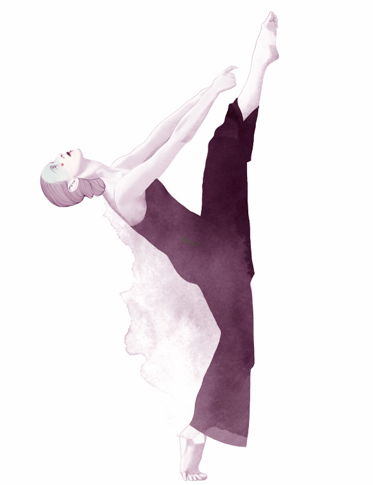
PORTRAIT OF A LEADER
Martha Graham
The Artistic Leader
She spoke often about sexuality, politics, history, psychology, and religion. She communicated strong messages with a powerful mastery of language. But, her language was not spoken by words, but rather, through movement. Her body was her art, and her passionate displays of expression through dance spoke on her behalf. Martha Graham was declared by Time Magazine as “Dancer of the Century.” She is notably regarded as the “mother of modern dance.” During a time where puritanical religiosity was predominant she danced seductively, provocatively, yet elegantly. In addition to dancing, she posed on many occasions for fine art nude photographers, seeking to make a statement about gender, sexuality, and politics. She pushed the edge not just for her times, but stretched the limits for dancers and artists of all time. She received invitations to perform before Presidents, Kings, Queens, Popes, and Dictators. She was utterly determined to push herself to the absolute limits of what was possible for the human body. She set the bar so high, that many in her industry have said that it is improbable that any dancer will ever come close to dethroning Martha Graham as the most influential dancer to ever grace the planet.

The Artistic Leader learns by persistent action in their various domains.
“I have spent all my life with dance and being a dancer,” she said. Martha Graham danced and choreographed for over seven decades. Dance was something she could not live without. So much, so that during a short absence away from dance, she became depressed and even suicidal. It was her life force. She had a groundbreaking style and is said to have “enlivened the body with raw, electric emotion.” Her dance was characterized as, “sharp, angular, and direct movements,” and as, “a dramatic departure from the predominant style of the time.” During her distinguished career, she created 181 dance compositions, which continue to challenge and inspire generations of dancers and enthusiasts. She was persistent in her action, believing that, “We learn by practice.” This was her philosophy on life. She has said, “Whether it means to learn to dance by practicing dancing or to learn to live by practicing living, the principles are the same.” She also believed that, “Practice means to perform, over and over again in the face of all obstacles, some act of vision, of faith, of desire. Practice is a means of inviting the perfection desired.”
The Artistic Leader instinctively composes great masterpieces.
Graham’s compositions have been emulated by dancers even decades after she first choreographed them. Her compositions have been deemed as masterpieces of 20th century American Modernism. Her influence on dance has been compared to the influence of Picasso on modern visual art, Stravinsky on music, and Frank Lloyd Wright on architecture. Graham was the first dancer ever to perform at the White House, earning the highest civilian award, the Presidential Medal of Freedom. She has also received honors ranging from the Key to the City of Paris, to Japan’s Imperial Order of the Precious Crown. Her style, “the Graham technique,” is taught worldwide, and her work has revolutionized the dance world and created what is known as modern dance. In 1998 Graham was named, “Dancer of the Century” by Time Magazine. She created “a movement language that pushed the expressive capability of the human body”. Her masterpieces were, “Consistently infused with social, political, psychological, and sexual themes.” Her choreography was viewed as being, “timeless, connecting with audiences past and present.”
The Artistic Leader leads by making statements through their art.
Graham had daring ideas, and she was audacious in the way she expressed them. Her movements were provocative, seductive, powerful, playful, and yet elegant. She had something to say about sexuality, gender, beauty, and psychology, but rather than using her words, she made her statements through her art. She pushed the limits of her own body’s potential, for she had much to say through dance. Graham exerted such control of her body that dancers gasped at what looked like impossible moves. The Graham method of speaking with the body was characterized by the movement of panthers. She trained her dancers on the ground, insisting that they develop “Pelvic Truth,” teaching them to “breathe from the vagina.” Primal sexuality was at the center of what she taught her protégées. She said, “I won’t have virgins in my company.” Early on, it was said that men could not be trained by her because they would have vagina envy. Her art spoke volumes on the vitality and strength of a woman’s sexuality, and of her superiority at a time when women were looked upon as less capable than men.
The Artistic Leader leads by quiet orchestration behind the scenes.
Starting from 1926, Graham’s work has quietly inspired major revolutions. She was not simply dancing to entertain, her movement language crossed barriers to effect politics, feminism, and religion. She has danced for Popes and Presidents, while declining an invitation from Hitler. She started out by crossing into all kinds of artistic genres, collaborating with fashion designers, Donna Karan and Calvin Klein, sculptor Isamu Noguchi, composer Aaron Copland, and she has taught entertainers like Kirk Douglas and Madonna. What we see on stage in the 21st century in rock concerts, ballets, and Broadway, finds its origins in what Graham started nearly a hundred years before. Her compositions are revered as far more than beautiful artwork. They are considered to be commentaries on the history and soul of America, a rebellion against puritanism, a major contribution to feminism, and a powerful force in the sexual revolution. Behind the scenes of the American stage stands a woman who created a movement language that defied race, religion, gender, and politics.
The Artistic Leader takes on new challenges to expand their art.
Graham once said, “Some men have thousands of reasons why they cannot do what they want to, when all they need is one reason why they can.” No challenge was ever too great for her. Wherever limitations existed, she sought to eliminate them. It mattered not that she arrived late to the art of dance (at age 23). Though new to the game, she had the audacity to create a dance with original roots. Her desire was to develop indigenous art that would be self-defined. Martha integrated and adapted dance traditions where she saw fit, and discarded what she deemed as inadequate to express that which was her own. She had no experience as an entrepreneur, and yet, she raised funds, attracted patrons, created fans and critics, recruited talent, and established the Martha Graham Dance Company as America’s first dance company (at age 32). What drove her was a dissatisfaction with what had been established thus far. She sought to defy the order. She believed that, “No artist is pleased. There is no satisfaction whatever at any time. There is only a queer, divine dissatisfaction; a blessed unrest that keeps us marching and makes us more alive than the others.”
